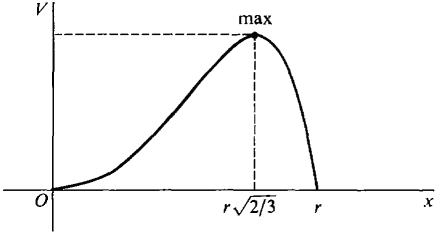| The ebook Elementary Calculus is based on material originally written by H.J. Keisler. For more information please read the copyright pages. |

|

Home  Continuous Functions Continuous Functions  Maxima and Minima - Applications Maxima and Minima - Applications  Examples Examples  Example 3: Inscribing a Cylinder Into a Sphere Example 3: Inscribing a Cylinder Into a Sphere  Solution One: Eliminating One Variable Solution One: Eliminating One Variable |
|||||||






|
|||||||
Solution One: Eliminating One Variable
Express V as a function of x by eliminating h.
The problem is to find the maximum of V in the interval 0 ≤ x ≤ r.
CONCLUSION The maximum of V is at
Then the ratio of x to h is x/h = 1/√2. Notice that, as we expected, this number does not depend on r.
Figure 3.6.5
|
|||||||
Home  Continuous Functions Continuous Functions  Maxima and Minima - Applications Maxima and Minima - Applications  Examples Examples  Example 3: Inscribing a Cylinder Into a Sphere Example 3: Inscribing a Cylinder Into a Sphere  Solution One: Eliminating One Variable Solution One: Eliminating One Variable |
|||||||
Last Update: 2006-11-25



 , (x < r).
, (x < r). , 4πx(r2 - x2) - 2πx3 = 0,
, 4πx(r2 - x2) - 2πx3 = 0,
 because 0 ≤ x ≤ r. The only interior critical point is
because 0 ≤ x ≤ r. The only interior critical point is 
 ,
, 
 (see Figure 3.6.5). At that point,
(see Figure 3.6.5). At that point, 
